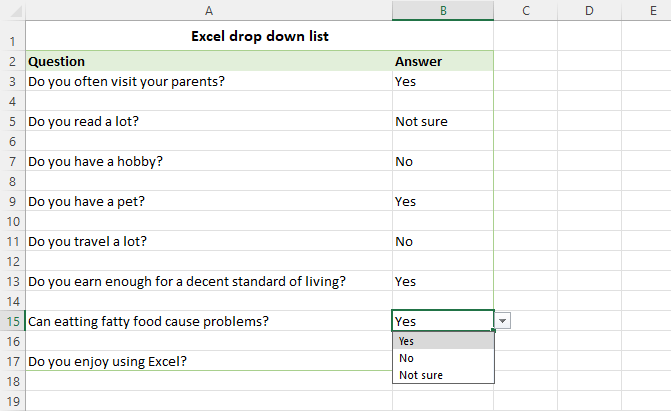Not known Details About Excel Links Not Working
Wiki Article
Not known Facts About Excel Links Not Working
Table of ContentsExcel Links Not Working Things To Know Before You BuyNot known Facts About Excel Links Not WorkingEverything about Excel Links Not WorkingThings about Excel Links Not WorkingThings about Excel Links Not Working

However, array computation functions like either can not deal with whole column referrals or determine all the cells in the column. User-defined features don't automatically identify the last-used row in the column and also, for that reason, frequently calculate entire column references inefficiently. Nonetheless, it is simple to program user-defined functions to make sure that they acknowledge the last-used row (excel links not working).

Excel Links Not Working Fundamentals Explained
Using the formula for a vibrant range is usually better to the formula since has the disadvantage of being an unpredictable feature that will certainly be computed at every recalculation. Performance decreases since the feature inside the vibrant array formula should take a look at several rows. You can reduce this efficiency decline by storing the part of the formula in a different cell or specified name, and afterwards describing the cell or name in the dynamic range: Counts!z1=COUNTA(Sheet1!$A:$A) Offset, Dynamic, Range=OFFSET(Sheet1!$A$ 1,0,0, Counts!$Z$ 1,1) Index, Dynamic, Variety=Sheet1!$A$ 1: INDEX(Sheet1!$A:$A, Counts!$Z$ 1+ROW(Sheet1!$A$ 1) - 1,1) You can additionally use functions such as to create dynamic varieties, yet is unstable as well as constantly determines single-threaded.
Making use of several vibrant arrays within a solitary column calls for special-purpose checking functions. Utilizing numerous dynamic ranges can lower efficiency. In Workplace 365 version 1809 and later, Excel's VLOOKUP, HLOOKUP, and also suit for precise match on unsorted information is much faster than ever before when seeking out multiple columns (or rows with HLOOKUP) from the very same table array.
If you utilize the exact suit choice, the estimation time for the feature is proportional to the number of cells scanned before a suit is found. Lookup time using the approximate suit options of,, and on arranged data is quick and also is not substantially boosted by the size of the variety you are looking up.
The Facts About Excel Links Not Working Revealed
Make certain that you comprehend the match-type and range-lookup options in,, and. The adhering to code example reveals the phrase structure for the function. MATCH(lookup worth, lookup array, matchtype) returns the biggest suit much less than or equivalent to the lookup worth when the lookup variety is arranged rising (approximate suit).The default alternative is approximate suit sorted ascending. The complying with code example shows the syntax for the you could try here and functions.
VLOOKUP(lookup value, table array, col index num, range-lookup) HLOOKUP(lookup value, table selection, row index num, range-lookup) returns the biggest suit much less than or equivalent to the lookup worth (approximate match). This is the default choice. Table selection should be arranged ascending. demands a precise match and also presumes the data is not arranged.
The Only Guide for Excel Links Not Working
If your data is arranged, yet you want a specific match, see Usage two lookups for sorted information with missing worths. Attempt utilizing the and also operates rather than. Is slightly much faster (about 5 percent faster), easier, as well as makes use of much less memory than a mix of and also, or, the additional flexibility that as well as deal commonly enables you to significantly save time.
The feature is rapid and also is a non-volatile function, which speeds up recalculation. The function is likewise quick; nevertheless, it is a volatile function, and also it occasionally significantly enhances the time taken to refine the computation chain.$A$ 2:$F$ 1000, MATCH(A1,$A$ 1:$A$ 1000,0),3) Due to the fact that specific match lookups can be slow, take into consideration the complying with choices for improving efficiency: Utilize one worksheet.
When you can, the data initially (is quick), and make use of approximate match. When you must make use of a precise match lookup, limit the variety of cells to be scanned to a minimum. Use tables as well as structured references or vibrant variety names instead of referring to a a great deal of rows or columns.
Things about Excel Links Not Working
Two approximate suits are considerably faster than one precise suit for a lookup over even more than a few rows. (The breakeven point has to do with 10-20 rows.) If you can sort use this link your information yet still can not make use of approximate suit since you can not make certain that the worth you are seeking out exists in the lookup array, you can use this formula: IF(VLOOKUP(lookup_val, lookup_array,1, Real)=lookup_val, _ VLOOKUP(lookup_val, lookup_array, column, True), "notexist") The very first part of the formula works by doing an approximate lookup on the lookup column itself.VLOOKUP(lookup_val, lookup_array, column, Real) If the answer from the lookup column did not match the lookup value, you have an absent worth, and also the formula returns from this source "notexist". Be aware that if you search for a worth smaller sized than the tiniest worth in the list, you get a mistake. You can manage this mistake by utilizing, or by including a tiny examination value to the list.
Beginning with Excel 2007, you can utilize the function, which is both simple as well as quick. IF IFERROR(VLOOKUP(lookupval, table, 2 FALSE),0) In earlier variations, an easy yet slow method is to utilize a feature that has two lookups. IF(ISNA(VLOOKUP(lookupval, table,2, FALSE)),0, _ VLOOKUP(lookupval, table,2, FALSE)) You can avoid the double specific lookup if you use exact once, save the cause a cell, as well as then check the outcome prior to doing an.
Report this wiki page